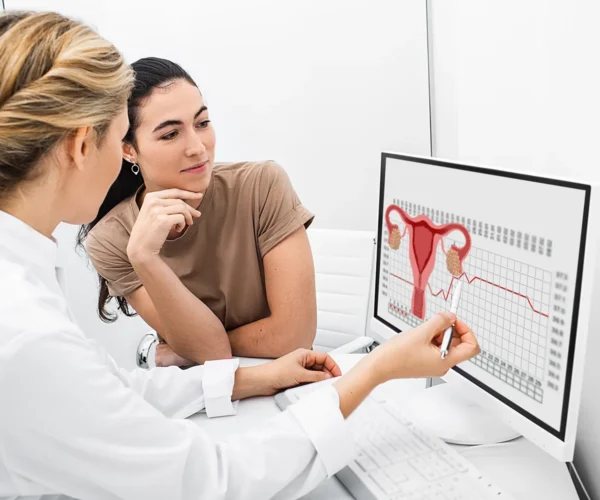
The AMH Test: Separating Fact from Fertility Fiction
In a study published this month in Human Reproduction, I was one of the authors who found that once women were given evidence-based information about the AMH test they were less likely to have further interest in being tested than if they received information from a commercial organisation.
Dr Devora Lieberman
Is the anti-Mullerian hormone (AMH) test a reliable test of my fertility?
Women* are born with their lifetime supply of eggs. The eggs are stored in the ovaries. These slowly drop in number and quality as women age. This means a woman’s age is the most important factor affecting her chance of having a baby. The anti-Mullerian Hormone (AMH) test is often promoted as a way for women to find out their chance of getting pregnant or when they will go through menopause. But this is NOT correct.
What is the anti-Mullerian hormone?
Follicles are little fluid-filled sacs that contain immature eggs in the ovaries. These follicles produce anti-Mullerian hormone (AMH). This helps follicles and eggs grow as part of the menstrual cycle. Because the number of follicles in the ovaries drops as women get older, the level of AMH also falls.
What is the AMH test? (Also called the egg timer or ovarian reserve test)
The AMH test measures the level of AMH in the blood. The level is a sign of the number of eggs left in the ovaries. But it can’t tell you anything about egg quality.
Originally published at: Human Reproduction Journal

For brevity and clarity, we use the terms ‘woman’ and ‘women’ throughout to encompass all individuals born with ovaries.
Can the AMH test tell me about my chances of getting pregnant?
The short answer is no. Research shows the test is not a reliable sign of a woman’s fertility.1 Pregnancy can still occur at low AMH levels, especially in young women. On average, women of the same age have roughly the same monthly chance of getting pregnant, regardless of their AMH level.2–4 The AMH test can also give false readings for women who use the contraceptive pill and for women with polycystic ovary syndrome.
Can the AMH test tell me when I will reach menopause?
No, the AMH test cannot reliably predict the start of menopause for individual women. Although AMH levels on average drop with age, the test is too imprecise and varies too much.5-6 It is also not clear whether repeated AMH testing gives a clearer picture.
What are the possible harms or downsides of having an AMH test?
Experts warn that women should not use the AMH test to make decisions about timing of pregnancy. A normal or high reading can give women a false sense of security that they can get pregnant even if they wait a few years. And a low reading can cause needless worry that time is running out. This may put pressure on women to try for a baby sooner than planned. Or they might feel unnecessary pressure to freeze their eggs.
Who might benefit from having an AMH test?
Fertility doctors may order an AMH test for women who need fertility treatment, such as IVF, or are planning to freeze their eggs. This is because the AMH level suggests how many eggs a woman is likely to get when fertility drugs stimulate the ovaries.7 It may help the woman to have realistic expectations about the number of eggs she might get. The AMH level may also help the doctor decide the dosing of fertility drugs. But it is still not clear how much changing the dose affects the number of eggs collected.8 It’s important to know that low or high AMH levels still do not reliably predict if a woman will have a baby after fertility treatment.7, 9
What is the cost of an AMH test?
The test costs around $80 to $120 Australian dollars.
There is no Medicare rebate.
Are there other tests I can have to tell me about my fertility?
There is no reliable test of a woman’s fertility. The only real way to know about your fertility is by trying to get pregnant when you are ready. But there are some things you can do to improve your chance of having a baby: Fertility drops with age. If you have a choice, trying for a baby sooner rather than later gives you the best chance of pregnancy.
At 35 years, the monthly chance of pregnancy is 15%. By age 40, the monthly chance of pregnancy is only about 5%.
Being a healthy weight, eating healthy food, regular physical activity, not smoking, and cutting out alcohol will boost your chance of having a healthy baby.
If you are planning to get pregnant, make an appointment with your doctor for a pre-pregnancy health check To learn more about fertility and preconception health, visit the Australian government-funded website, Your Fertility www.yourfertility.org.au.

Human Reproduction Journal Volume 39, Issue Supplement_1, July 2024
Glossary
Ovaries – the female reproductive organ where female hormones are made and the follicles are stored.
Menopause is the time in life when the ovaries stop producing hormones and the menstrual period stops. This usually occurs around 50 years of age.
Fertility – the ability to have a baby.
Pregnancy – the period when a baby develops inside the womb.
Polycystic ovary syndrome – a female medical condition involving abnormal hormone levels, often causing irregular periods.
Preconception health care – the medical care a woman or man receives from their doctor to increase their chance of having a healthy baby. Includes discussions about any medical conditions, your lifestyle, any medications, and vaccinations.
References
1. Lin C, et al. The Value of Anti-Müllerian Hormone in the Prediction of Spontaneous Pregnancy: A Systematic Review and Meta-Analysis. Frontiers in Endocrinology. 2021:1260.
2. Hagen CP, et al. Low concentration of circulating anti-Müllerian hormone is not predictive of reduced fecundability in young healthy women: a prospective cohort study. Fertility and Sterility. 2012 Dec 1;98(6):1602-8.
3. Steiner AZ, et al. Association between biomarkers of ovarian reserve and infertility among older women of reproductive age. JAMA. 2017 Oct 10;318(14):1367-76.
4 Zarek SM, et al. Is anti-Müllerian hormone associated with fecundability? Findings from the EAGeRtrial. Journal of Clinical Endocrinology & Metabolism. 2015 Nov 1;100(11):4215-21.5
5. Depmann M, et al. Does AMH relate to timing of menopause? Results of an individual patient data meta-analysis. Journal of Clinical Endocrinology & Metabolism. 2018 Oct;103(10):3593-600.
6 De Kat AC, et al. Role of AMH in Prediction of Menopause. Frontiers in Endocrinology. 2021:1078.
7 Broer SL, et al. Added value of ovarian reserve testing on patient characteristics in the prediction of ovarian response and ongoing pregnancy: an individual patient data approach. Human Reproduction Update. 2013 Jan 1;19(1):26-36.
8 Lensen SF, et al. Individualised gonadotropin dose selection using markers of ovarian reserve for women undergoing in vitro fertilisation plus intracytoplasmic sperm injection (IVF/ICSI). Cochrane Database of Systematic Reviews. 2018(2).
9 Iliodromiti S, et al. The predictive accuracy of anti-Müllerian hormone for live birth after assisted conception: a systematic review and meta-analysis of the literature. Human Reproduction Update. 2014 Jul 1;20(4):560-70.
Originally published at: Human Reproduction Journal
